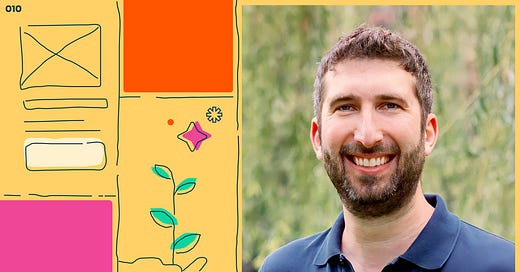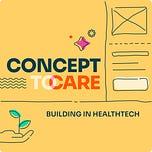Mike Gleichman is the VP of Product at knownwell, a pioneering post-Series A company transforming healthcare with its weight-inclusive care model. Mike brings a unique blend of creativity and analytical thinking, with a background in quantitative economics from Tufts and jazz performance from the New England Conservatory of Music. He has honed his skills in product management through roles at athenahealth and CVS's Aetna. In our conversation, Mike talks about:
His journey from professional services to product management
His thoughts on product operations and effective use of OKRs
knownwell's comprehensive care model and strategies for addressing weight stigma
Achieving product-market fit and building a written culture
Feedback and user testing processes at knownwell
Strategic use of AI in their technology stack
The recent acquisition of Alfie to enhance clinical decision support
Balancing operational efficiency and user-centered design
Continuous adaptation to meet evolving patient needs
Mike’s insights underscore the necessity of integrating technology with empathetic care to drive healthcare innovation.
Some takeaways
The Journey to Product Leadership: Mike Gleichman's career journey is a testament to the power of transferable skills and strategic career moves. Starting at athenahealth in a professional services role, Mike was on the front lines, working closely with healthcare providers and understanding their challenges. This experience was pivotal in shaping his understanding of healthcare workflows and user needs. Over time, he transitioned to various product roles, including product operations, strategy, and management. Mike detailed his transition into product management, highlighting several key steps:
Identifying Transferable Skills: Mike realized that his skills in professional services—such as understanding user workflows and managing stakeholder relationships—were highly transferable to product management.
Building a Network: He networked within athenahealth, seeking mentors and learning from colleagues who had already made the transition to product roles.
Continuous Learning: Mike invested time in learning about product management through resources like the book "Cracking the PM Interview," which helped him understand the expectations and prepare for the role.
Strategic Moves: He methodically planned his career steps, moving from professional services to product operations, then to product strategy, and finally to product management.
The Role of Product Operations: At Athena Health, Mike was part of a pioneering effort to establish product operations, working alongside Melissa Perri. He provided a comprehensive definition and vision for product operations:
Definition: Product operations, as defined by Mike, involves taking on some of the more administrative work from product managers, such as recruiting clients for alpha or beta testing, gathering feedback, documenting processes, and internal communication.
Purpose: The primary goal of product operations is to enable product managers to focus on strategic decisions and user interactions by offloading administrative and operational tasks.
Implementation: Mike emphasized that product operations should work closely with product managers to avoid creating a disconnect between them and the end-users. It's crucial for product operations to support product managers without becoming a barrier to user insights.
Risk Mitigation: He highlighted the risk of inadvertently creating distance between product managers and users, stressing the importance of maintaining direct lines of communication to ensure that product decisions remain well-informed and user-centered. He also shared alternative ways to reduce the administrative burden on product managers, like using software to solicit user feedback and curating a pool of users from which to recruit for testing.
Practice of Product Management: Mike shared his viewpoints on the practice of product management, emphasizing the importance of using frameworks and tools to drive effective decision-making and alignment:
Frameworks: Mike uses frameworks like OKRs (Objectives and Key Results) to align company strategy with actionable goals. He particularly values OKRs for their simplicity and power in providing clarity and cross-functional alignment. He recommends the book "Measure What Matters" by John Doerr for anyone interested in understanding and implementing OKRs effectively.
Tooling: knownwell leverages a suite of tools to gather user insights and streamline processes. Tools like Datadog and Mixpanel are used for tracking user behavior and analyzing data, while user panels and surveys help gather targeted feedback from specific demographics.
Why It Matters: Using frameworks and tools ensures that product management decisions are data-driven and aligned with user needs. This approach helps prioritize features and improvements that will have the most significant impact on users, leading to higher satisfaction and better product-market fit.
knownwell’s Comprehensive Care Model: knownwell’s care model provides a comprehensive, personalized approach to treating patients with obesity. knownwell offers both in-person and virtual care and their care teams are multidisciplinary, including physicians and advanced practice clinicians, dietitians, health coaches, and behavioral health specialists. This model ensures that patients receive continuous, integrated care that addresses both medical and psychological needs. By incorporating lifestyle factors into their treatment plans, knownwell aims to provide a more effective and sustainable solution for patients. Mike explained that this holistic approach helps ensure long-term success for patients by focusing on personalized, ongoing care rather than just short-term treatment options.
Addressing Weight Stigma in Healthcare: knownwell is proactive in addressing weight-related stigma, a significant barrier for many patients with obesity. Mike emphasized several tactical steps that knownwell has implemented to create a more inclusive and respectful environment:
Training Staff: All staff undergo training to foster empathy and non-judgmental communication. This ensures that every patient interaction is supportive and respectful.
Designing for Comfort: The physical environment at knownwell clinics is designed to be welcoming and accommodating for patients of all body types. This includes comfortable chairs in waiting rooms and specialized exam tables that can discreetly weigh patients.
Patient-Centered Policies: knownwell has implemented policies that prioritize patient dignity and comfort. This includes having procedures that respect patient privacy and reduce any potential for embarrassment or discomfort.
Consistent Feedback Loops: Regular feedback from patients is sought to continuously improve the environment and interactions. This ensures that knownwell can adapt and address any concerns promptly.
Effective use of OKRs at knownwell: OKRs are a critical tool for aligning company strategy with actionable goals. Mike described a thorough process for setting OKRs that involves input from all levels of the organization. Here are some key steps for implementing OKRs effectively:
Annual Planning: The OKR planning process typically takes about a month and is done towards the end of the year for the upcoming year. It involves gathering input from all levels of the organization to ensure comprehensive alignment.
Layered Approach: Start with top-level company OKRs and then develop OKRs for each department (technology, operations, clinical, etc.) that ladder up to the company objectives. This ensures that all teams are working towards the same strategic goals.
Cross-Functional Alignment: Engage with leaders from different departments to ensure their goals do not conflict. For example, technology and operations goals should complement each other rather than compete for resources.
Team Involvement: Review the proposed OKRs with the respective teams to get their input on feasibility and any missing elements. This collaboration ensures that the goals are realistic and supported by those responsible for achieving them.
Regular Check-ins: Throughout the year, conduct regular check-ins to track progress, address any misalignments, and adjust as necessary. This ongoing alignment helps keep everyone focused and working efficiently towards the goals.
Achieving Product-Market Fit at knownwell: knownwell has achieved product-market fit with its care model, as evidenced by exceptionally high Net Promoter Scores (NPS) in the 90s and rapid patient growth driven primarily by referrals and word-of-mouth. These indicators reflect strong patient satisfaction and trust in knownwell's services. However, from a technology standpoint, Mike acknowledged that there is still work to be done. The company is continuously evolving its digital tools and internal systems to better support both patients and care teams, striving to enhance the overall user experience and operational efficiency. Mike explained that the focus on continuous improvement and adaptation is key to maintaining product-market fit over time. knownwell plans to invest in:
Customized Digital Tools: Building more customized and integrated digital tools that cater specifically to their operational workflows and patient interactions, rather than relying solely on standard off-the-shelf solutions.
Seamless Experience: Creating a seamless experience for both patients and care teams, ensuring that the technology supports the high standards of care that knownwell is committed to providing.
Building a written culture: Mike advocates for a written culture within organizations, emphasizing that documenting strategies, decisions, and processes ensures clarity and consistency. Written documents serve as a lasting reference that can be revisited and refined over time, unlike presentations that capture only a moment. This practice fosters thoroughness in decision-making and helps new team members understand the rationale behind strategic choices. At knownwell, this approach helps maintain alignment and continuity, particularly as the company scales and evolves.
User Testing at knownwell: knownwell employs rigorous user testing not just for their software but also for the overall patient experience. Mike described their comprehensive approach:
Gathering User Insights: Utilizing tools like Datadog and Mixpanel to track user behavior and analyze data.
Concept Testing: Putting wireframes in front of users to gather feedback and ensure intuitive design.
Clinical Operations Standpoint: Evaluating the entire patient journey, from the registration process on the website to follow-up interactions, to identify improvement opportunities.
Targeted Feedback: Conducting user research to understand pain points and preferences, ensuring that every aspect of the patient experience meets high standards.
Technology Stack and AI at knownwell: Mike provided insights into the technology stack at knownwell, emphasizing the importance of integrating various tools to support comprehensive patient care. The technology includes patient apps, internal tools for care teams, and optimized off-the-shelf solutions.
When it comes to AI, knownwell follows guiding principles that balance the decision to build versus buy. Key points include:
Strategic Use of AI: AI is used to enhance clinical decision support, automate repetitive tasks, and standardize processes like clinician headshots.
Build vs. Buy Decisions: knownwell evaluates whether existing solutions can meet their needs effectively. For example, they acquired Alfie to leverage its AI capabilities for clinical decision support, rather than building a new solution from scratch.
Integration Strategy: Ensuring that all tools work seamlessly together through robust API support, making integration with existing systems like athenahealth smooth and efficient.
—
Where to find Mike Gleichman:
—
Where to find Angela and Omar:
Angela Suthrave
Omar Mousa
—
Referenced:
knownwell: https://www.knownwell.co/
Alfie: https://www.joinalfie.com/
athenahealth: https://www.athenahealth.com/
Cracking the PM Interview: https://www.crackingthepminterview.com/
Product Operations by Melissa Perri and Denise Tilles: https://www.productoperations.com/
Measure what Matters by John Doerr: https://www.whatmatters.com/
MoSCoW to define MVP: https://medium.com/@cjjharries/using-the-moscow-method-to-design-an-mvp-c683f3de48a7
Tradeoff decision between 2 MVPs or between non-MVP items: RICE Method: https://www.productplan.com/glossary/rice-scoring-model/
Software methodologies: Scrum: https://www.atlassian.com/agile/scrum
Gathering user insights: Datadog: https://www.datadoghq.com/
Dashboards: Mixpanel: https://mixpanel.com/
—
Check out our website: https://www.concepttocare.com
Follow us and Subscribe wherever you get your podcast:
















Share this post